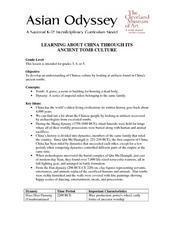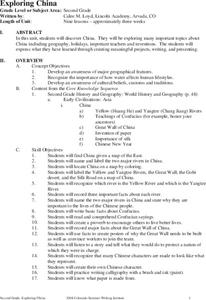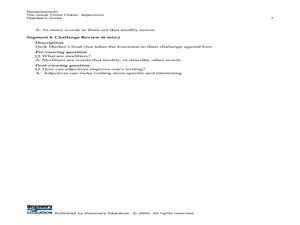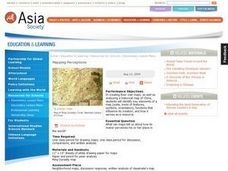Curated OER
Social Studies: Ancient China
Seventh graders examine the contributions and influences of dynasties on Chinese history. They role-play as citizens during selected dynasties and write daily autobiographical entries. Students complete projects on the geography,...
Curated OER
The History of Money
In this social studies worksheet, young scholars investigate the history of paper money and coins. Students read paragraphs about what early people used for money and what kinds of banks were used. Young scholars complete a crossword...
Curated OER
China's Ancient Tomb Culture
Students research and discuss Chinese history through the examination of ancient tomb artifacts. Emphasis is placed on the creation of student posters displaying "what they would put in a tomb".
Curated OER
Welcome to The Immortal Emperor
Students watch a flim while collecting information about China in the third Century BC and about its First Emperor, Qin Shihuangdi. They examine the tools use by archeologist and investigate the human quest for immortality in this series...
Curated OER
Sports in China: What And Why They Play?
Students study several different types of Chinese sports played throughout history in China. They examine the historical perspective of the importance of sports in Chinese culture and create a final project using information about three...
Curated OER
The Ancient Mediterranean: Trade, Contact, and Cultural Diffusion
Ninth graders begin the instructional activity by being introduced to the basic terms of economics. In groups, they discover how they are affected by trade because of the clothes they wear and foods they eat. Using primary sources,...
Curated OER
Paper: Scientific Inquiry Through Chinese Art
Students create replicas of Chinese hanging scrolls in an attempt to understand the technology behind the creation and use of paper in Ancient China. This three-day lesson includes enrichment ideas.
Curated OER
Rome: Republic to Empire
Sixth graders discuss the rise of Rome from a republic to a dictatorship. In small groups, they role-play as congress people debating whether or not to give the president more powers. In another activity, 6th graders produce television...
Curated OER
Contributions of Ancient Egypt and China
Second graders study the contributions of Ancient Egypt and China, which have had an impact on world history, with emphasis on written language, laws, calendars, and architectural monuments such as the Pyramids and the Great Wall of China.
Curated OER
Chapter 9: A Surprising Day and A Little Bit About China
Fifth graders complete activities with Chapter 9 of the book The Fastest Pig in the West by Randi Hacker. For this literature lesson, 5th graders discuss the concept of saving face and how it affects the main character's decisions....
Curated OER
Renaiisance In Ancient Egypt
Eleventh graders conduct research about the development of technologies in Ancient Egypt. The research is used to make class presentations. The students work with the teacher in order to create a rubric for the assignment.
Curated OER
What Is the History of the Consumption of Rice?
Sixth graders research the history of rice consumption. In this rice consumption lesson, 6th graders read a study guide and answer comprehension questions about two rice dishes and rice cultivation.
Curated OER
The History of Silk
Sixth graders study the history of silk-making in China. They investigate the silkworm and follow the trade route of the Silk Road. They research other Chinese inventions.
Curated OER
Architecture of China- A Web Based Search
Students use the internet in order to investigate the architecture of China. This is done in order to build an appreciation for the structures of buildings and how they communicate the culture.
Curated OER
Exploring China
Second graders explore the geography, holidays, important teachers, and inventions from China in the nine lessons of this unit. The results of their inquiries are expressed through a variety of products, writings, and presentations.
Curated OER
The Great China Chase: Adjectives
Stories are created, by students, using a variety of adjectives. 3-5th graders will learn about adjectives and use their new knowledge to create ad-lib stories to share with the class demonstrating their mastery of adjectives, indefinite...
Curated OER
China's Ethnic Minorities
Third graders are introduced to various Chinese ethnic groups. They consider how geography affects ethnic groups and examine artifacts produced by Chinese peoples. They prepare a presentation of their research and artifact interpretation.
Curated OER
Mapping Perceptions
Students create and read maps. In this map skills lesson, students draw a map of their neighborhood, then use skills acquired during map-making to interpret a classmates map and a map of the Ming Dynasty.
Curated OER
Chinese Inventions A Selected History of Science and Invention in China
Students study the history of Chinese technology by identifying when and where items were invented or discovered.
Curated OER
Wushu Were Here
Young scholars create a fan-shaped story screen that explains 4 major points surrounding various facts, myths, expressions, or story elements in Chinese history, culture and/or literature.
Curated OER
China
Sixth graders become more aware of how land features, climate, and vegtation affect civilization. Students are divided into groups and research one of China's regions. They make a relief of their designated area.
Curated OER
When in Rome...
Students discuss Roman social classes and create a graphic organizer illustrating each social class and its characteristics. They dress in costumes representative of their social classes as part of a Rome Day experience.
Curated OER
Who Was Marc Antony?
Students explore the relationship between Marc Antony and Cleopatra. In this World History lesson, students research Marc Antony, Julius Caesar and Cleopatra, then answer specific questions about how they are all related. Activities...
Women in World History Curriculum
Women and Confucianism
Young historians consider the far-reaching effects of traditional teachings on the debates about the current attitudes toward women in society. The discussion begins with a list of New-Confucian sayings and expands to a global perspective.

























